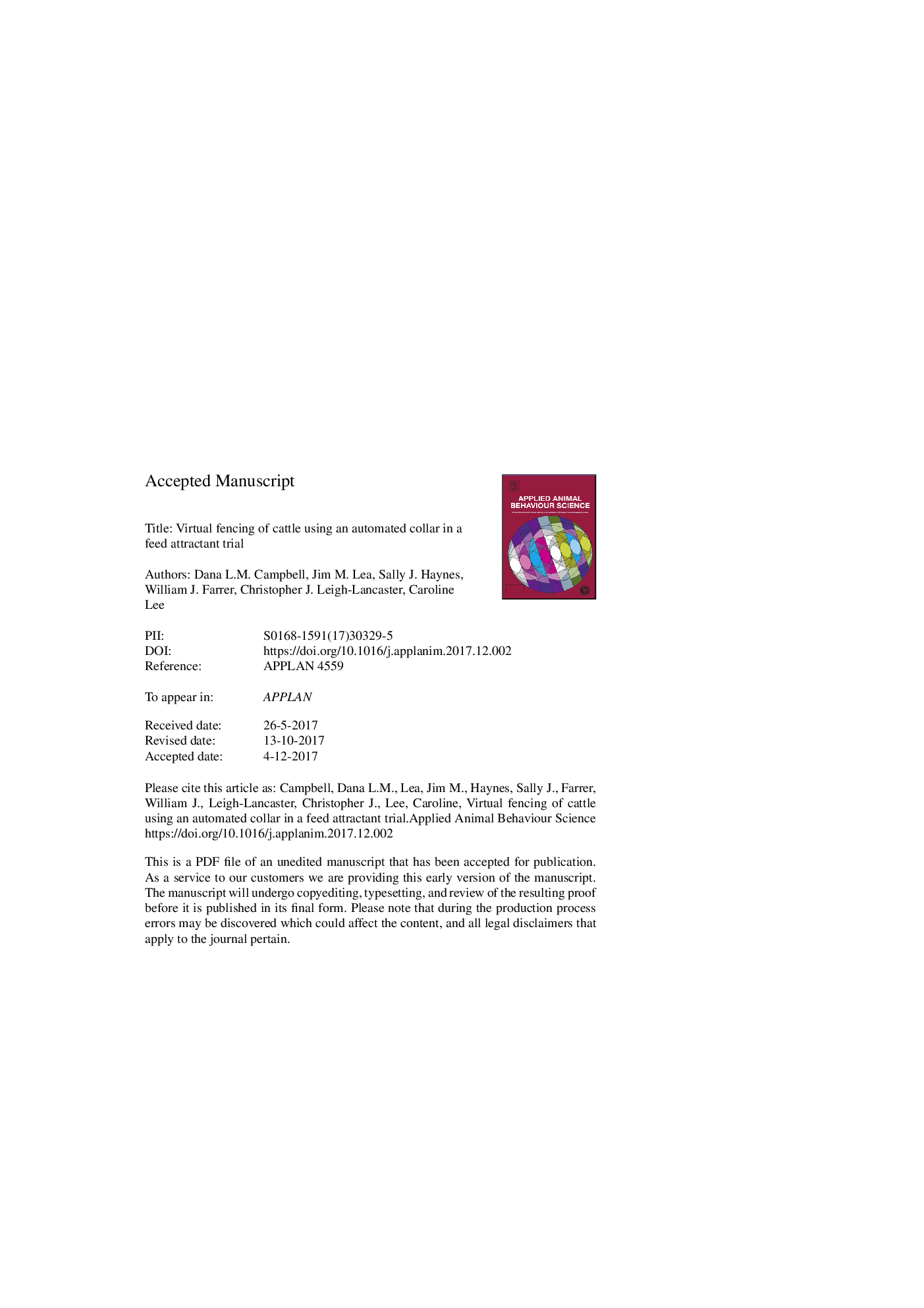| کد مقاله | کد نشریه | سال انتشار | مقاله انگلیسی | نسخه تمام متن |
|---|---|---|---|---|
| 8882831 | 1625306 | 2018 | 19 صفحه PDF | دانلود رایگان |
عنوان انگلیسی مقاله ISI
Virtual fencing of cattle using an automated collar in a feed attractant trial
ترجمه فارسی عنوان
شمشیربازی مجازی گاو با استفاده از یک یقه خودکار در یک محاکمه جذب
دانلود مقاله + سفارش ترجمه
دانلود مقاله ISI انگلیسی
رایگان برای ایرانیان
کلمات کلیدی
یادگیری وابسته تنوع فردی، رفتار - اخلاق، فن آوری،
موضوعات مرتبط
علوم زیستی و بیوفناوری
علوم کشاورزی و بیولوژیک
علوم دامی و جانورشناسی
چکیده انگلیسی
Managing grazing cattle can be challenging in environmentally-sensitive areas or when there is limited contact with and control over the animals. Virtual fences - barriers without a physical barrier - represent the potential for animal guidance in locations where physical fences may be unfeasible. In this study automated collars that provided audio and electrical stimuli to cattle were tested on 12 naïve heifers to determine if cattle could be deterred from a feed attractant in a series of 3 test paddocks. All animals were individually trained (no virtual fence line set) across 3 days (each paddock once per day) to walk unrestricted down to a bale of hay. The heifers were then each fitted with the experimental prototype collar device and a virtual fence line was set across the width of each paddock to restrict animals from the hay reward. As the animal approached the virtual fence line the collar emitted a 2.5 s audio cue (785 Hz ± 15 Hz, 58DB). If the animal stopped or turned away no further cues were emitted, if the animal continued forward an electrical stimulus (800 V electrical pulses delivered in less than 1 s) was applied immediately following the audio cue. The audio-electrical stimulus sequence was repeated as animals continued into the exclusion zone (where the hay was located). Each animal was tested in each paddock across 3 days reaching a total of 8 trials when animals were no longer voluntarily approaching the hay. Logistic regression analyses showed a mean number of 6 interactions with the fence line until 50% of animals were learning to avoid the fence line based on the audio cue. The odds ratio of 1.28 (95% CI 1.14-1.44) showed that with each fence interaction, animals were 28% more likely to appropriately respond to the audio cue and avoid the electrical stimulus (Likelihood Ratio Test Ï2 = 21.51, DF = 1, P < 0.0001). However, there was high variation between individual animals in their rate of learning and the behaviours they exhibited in response to both the audio and electrical stimuli. The automated collars were able to successfully exclude the majority of animals from accessing the hay but further research should aim to assess the impacts of group dynamics on individual behavioural variation and how aspects of temperament or cognition may influence learning of a virtual fencing system.
ناشر
Database: Elsevier - ScienceDirect (ساینس دایرکت)
Journal: Applied Animal Behaviour Science - Volume 200, March 2018, Pages 71-77
Journal: Applied Animal Behaviour Science - Volume 200, March 2018, Pages 71-77
نویسندگان
Dana L.M. Campbell, Jim M. Lea, Sally J. Haynes, William J. Farrer, Christopher J. Leigh-Lancaster, Caroline Lee,
